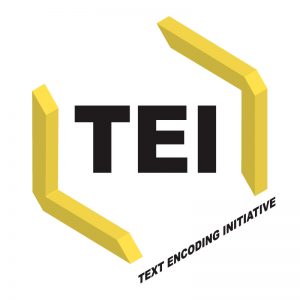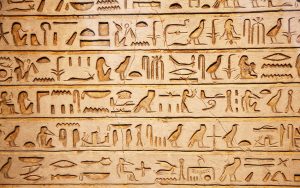Ancient Hieroglyphs (3200 BCE- 1822 CE)
Hieroglyphic writing was a system invented and used by the ancient Egyptians. Hieroglyphs are the oldest examples of script to date. In the beginnings of this writing system, the Greeks and Egyptians believed hieroglyphics to be sacred text, a gift from God, hence, the name hiero for ‘holy’ and glypho for ‘writing’ in the ancient Greek language. In the ancient Egyptian language, hieroglyphs were called medu netjer, ‘the gods’ words’ (Scoville, 1). The script was created of three basic types of signs. Logograms represented words in the writing, while phonograms represented sounds. The third sign is called determinatives, placed at the end of the word to help clarify its meaning. Scoville explains that as a result of this systematic writing, Egyptians used over a thousand different hieroglyphs and during the Middle Kingdom (2055-1650 BCE) the numbers of symbols used were reduced to about 750 (1).
The origins of hieroglyphs remain unclear. Some believed that the Egyptians learned to write from the Sumerians, who also began writing about the same time, about 3000 BC. However, the Egyptian hieroglyph does not look or work the same as the Sumerian form of writing, cuneiform (Carr, 1). The most popular hypothesis is that hieroglyphs derived from rock pictures dating back to prehistoric hunting communities in the dessert west of the Nile. It is believed that these prehistoric people were familiar with the concept of communicating by use of visual imagery. During the Naqada II period (c. 3500-3200 BCE), the motifs depicted on rock images were also found on pottery vessels of early Pre-dynastic cultures in Egypt. Hieroglyphic inscriptions are known to display stories of Gods, Demigods and half human half animal like figures, but they also contain inscribed numbers and mathematics. In fact, it is believed that the most complex inscription of administrative information related to economic activities was founded on pottery and stone vessels from tombs of Dynasty. This is the earliest recorded use of, what we would call, accounting data and taxation analysis for administrative purposes (Scoville, 4). Scoville goes on to explain the transition towards the Late Early dynastic (c. 3000 BCE), where examples of writing to commemorate royal achievements was found (5). In this case, hieroglyphic writing is found funerary stone and votive palettes, to honor the memory of the rulers and their achievements. The decline of Egyptian hieroglyphs took place during the Roman period (30 BCE- 395 CE) as Greek and Roman culture became more influential. Toward the second century CE, Christianity played a significant factor in the decline of hieroglyphs, as it displaced traditional Egyptian cults, making their system of writing obsolete.

The Papyrus Scroll (3000- 2890 BCE)
Papyrus appeared onthe scene during the First dynasty (3000- 2890 BCE), and became the most common source of portable writing in Egypt (Scoville, 3). Writng on clay tablets were quickly discontinued. What in the world is a Papyrus you ask? Papyrus is a plant that once grew, only, along the Nile River. Egyptians would cut the long papyrus stalks into thin slices and soak them in water and then stack them on top of each other in a weaving-like pattern. Then, they would pound the slices together until it created a flat material similar to paper. (Video: How to make papyrus paper) https://youtu.be/DCR8n7qS43w
Egyptians were the first to adapt this method of papyrus as a portable writing tool. By 1000 BC papyrus was in great demand because it was more convenient than clay tablets. This created great business as people from all over West Asia bought papyrus from Egypt. Since papyrus only grew in Egypt this particular item was in high demand. As a result, the price of papyrus was high. Around 700 AD the Islamic Empire learned from the Chinese how to make paper from rags from the, people quickly stopped using papyrus. Although the invention of paper from papyrus was short lived, it sparked the need for a portable writing system and revolutionized writing in terms of communication and how far information could go.

1987-2007
The TEI Consortium is a nonprofit membership organization composed of academic institutions, research projects, and individual scholars from around the world. Members of the initiative are responsible for maintaining a standard for representation of text in digital form. TEI consortiums follow a set of guidelines which specify encoding methods for machine-readable texts, mainly in disciplines such as the humanities, social sciences and linguistics. Before TEI creating sustainable and shareable textual material for archival and academia uses on a representing computer system was unheard of and not yet developed. This inhibited the development of the full potential of computers to support humanistic inquiry, while creating new problems for preservation and data sharing difficult. The TEI was originally developed maintain, and promulgate hardware- and software-independent methods for encoding humanities data in electronic form. TEI was a successful attempt to take on the challenges of digital technology. The goal of establishing the TEI Consortium was to maintain a permanent home for the TEI as a democratically constituted, academically and economically independent, non-profit organization. In addition, the TEI Consortium was intended to foster a broad-based user community with sustained involvement in the future development and widespread use of the TEI Guidelines. In both of these goals the Consortium has proven to be a positive step towards digital technology and communication as we know it, today. The TEI is internationally recognized as a critically important tool, for the long-term preservation of electronic data, and as a means of supporting effective usage of such data among many disciplines. TEI is the encoding scheme of choice for the production of critical and scholarly editions of literary texts, for scholarly reference works and large linguistic corpora (TEI: History, 4). The success of the TEI has catapulted our society in ways of ensuring that our cultural heritage will be brought forward into the emerging and forever changing, new world of technology.

Work Cited
Carr, K.E. “What is Papyrus?”What is Papyrus? – Ancient Egypt – Ancient Papyrus – Quatr.us. N.p., 01 Sept. 2016. Web. 26 Feb. 2017.
Scoville, Priscila. “Egyptian Hieroglyphs.”Ancient History Encyclopedia. N.p., n.d. Web. 26 Feb. 2017.
TEI: Text Encoding Initiative.”TEI: Text Encoding Initiative. N.p., n.d. Web. 26 Feb. 2017.

